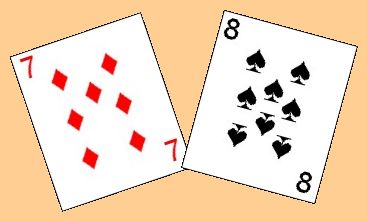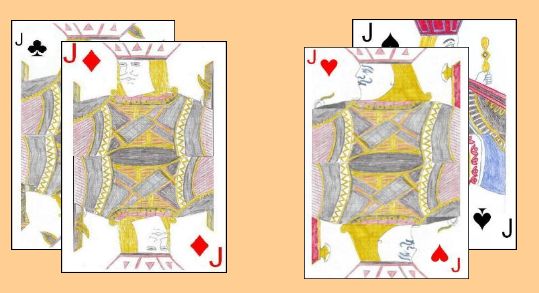How To Play Switch
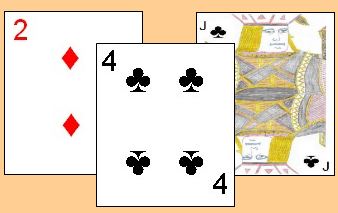 Switch (also sometimes called Two-Four-Jack) is a fun and exciting card game for two or more players. This game is fun for all ages and easy to learn. It is similar to the popular game Crazy Eights, and several commercial games have been marketed based on the rules of Switch.
Switch (also sometimes called Two-Four-Jack) is a fun and exciting card game for two or more players. This game is fun for all ages and easy to learn. It is similar to the popular game Crazy Eights, and several commercial games have been marketed based on the rules of Switch.One standard 52 card deck is used for playing Switch, however if more than 5 players are playing, two standard 52 card decks should be used, shuffled together. The first dealer can be determined in various ways. One common method is for any player to start dealing cards out one by one to each player. The first player to receive any spade becomes the first dealer. Thereafter, the deal rotates clockwise around the table after each completed hand.
Once the dealer is determined, he shuffles the entire deck and deals one card at a time to each player, clockwise around the table, starting with the player at his immediate left. For two or three players, each should receive 12 cards, but if there are more players, each should receive 10. These cards are dealt face down in front of each player. The remainder of the deck is placed face down in a squared pile in the center of the table. This stack is called the stock pile. The dealer then flips over the top card of the stock pile, called the starter card. If this starter card is any of the "special" cards (see below), the dealer will continue to flip over the next card until it is not one of these special cards.
Play of the hand begins with the player to the immediate left of the dealer and each player follows in a clockwise direction around the table. On his turn a player, after examining his hand may then play one card from his hand on top of the exposed starter card, if able. In order for a card to be able to be played, it must match the starter card in suit or rank. Thus a diamond suited card could be played on any other diamond suited card or a card with a rank of nine could be played on another card of rank nine regardless of the suits of the nines. Aces, Kings and Queens are each considered a separate rank, thus a Queen could be played on another Queen or another card of its same suit, but it could not be played on a King of a different suit. If a player cannot (or chooses not to) play one of his cards, he must draw cards, one at a time, from the stock pile until they receive a card they can or want to play at which time they play it to the center pile. Once a player plays a legal card to the starter pile, their turn ends and the next player in sequence continues in this same manner.
In the game of Switch, there are various "special" cards that a player may contain in his hand and play during the course of his turn. Each of these cards, when played, alters the gameplay in some manner. These "special" cards (often called Power cards), along with their affect on the game are as follows:
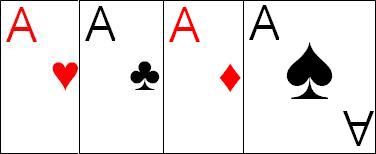 Aces: All Aces are considered somewhat of a wild card. Thus a player, on his turn, can play an Ace on another card, regardless of the rank and suit of the top, exposed card on the center pile. When playing an Ace, the player must declare the suit to which the next player must play (the suit named does not need to name the same suit as that of the Ace that the is played). The next player must then play a card of the named suit or another Ace. If unable to play such a card, he must then draw until obtaining a card for which he can legally play. If the Ace played was the last card in the players hand, that player is the winner of that hand and the hand immediately ends and is scored (see scoring below). Although an Ace may be played on any other card on it's owners proper turn, the next player in turn after a two or four is played may not use it to avoid drawing the requisite number of cards.
Aces: All Aces are considered somewhat of a wild card. Thus a player, on his turn, can play an Ace on another card, regardless of the rank and suit of the top, exposed card on the center pile. When playing an Ace, the player must declare the suit to which the next player must play (the suit named does not need to name the same suit as that of the Ace that the is played). The next player must then play a card of the named suit or another Ace. If unable to play such a card, he must then draw until obtaining a card for which he can legally play. If the Ace played was the last card in the players hand, that player is the winner of that hand and the hand immediately ends and is scored (see scoring below). Although an Ace may be played on any other card on it's owners proper turn, the next player in turn after a two or four is played may not use it to avoid drawing the requisite number of cards.
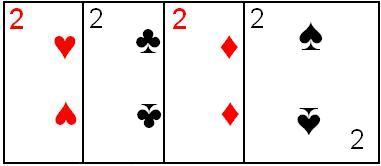 Twos: Twos acts as a sort of penalty card for the next player in turn. When a two is played, the next player must draw two cards from the top of the stock and misses the turn, with the turn passing to the next player whose turn normally follows that player in sequence.
However, if the player who was to draw has a two of their own in their hand, they may play it, thus avoiding the penalty (not needing to draw two cards from the stock). In this case, the subsequent player in their turn, must either play their own two or must draw four cards and miss their turn. If this player also has and plays a two, the following player must then draw six cards and miss a turn. This can continue, as twos are played, with the first player unable to play a two forced to draw two cards for each two played in series, and also missing their turn. After a player has drawn the appropriate number of cards and missed their turn, the next player may play normally, including playing a two on the two that was just played. If this does occur, the sequence begins again with the next player needing only to draw two if not having a two of their own to play.
Twos: Twos acts as a sort of penalty card for the next player in turn. When a two is played, the next player must draw two cards from the top of the stock and misses the turn, with the turn passing to the next player whose turn normally follows that player in sequence.
However, if the player who was to draw has a two of their own in their hand, they may play it, thus avoiding the penalty (not needing to draw two cards from the stock). In this case, the subsequent player in their turn, must either play their own two or must draw four cards and miss their turn. If this player also has and plays a two, the following player must then draw six cards and miss a turn. This can continue, as twos are played, with the first player unable to play a two forced to draw two cards for each two played in series, and also missing their turn. After a player has drawn the appropriate number of cards and missed their turn, the next player may play normally, including playing a two on the two that was just played. If this does occur, the sequence begins again with the next player needing only to draw two if not having a two of their own to play.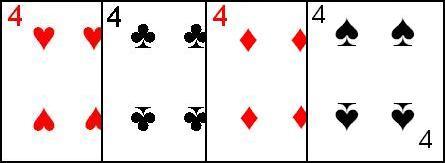
Fours: Any time a four is legally played, it acts similar to a two, as above. However, instead of needing to draw 2 cards for each two played in sequence, four cards must drawn for each consecutive four that is played, unless the player can play a four from their own hand (in which they avoid drawing the additional cards).
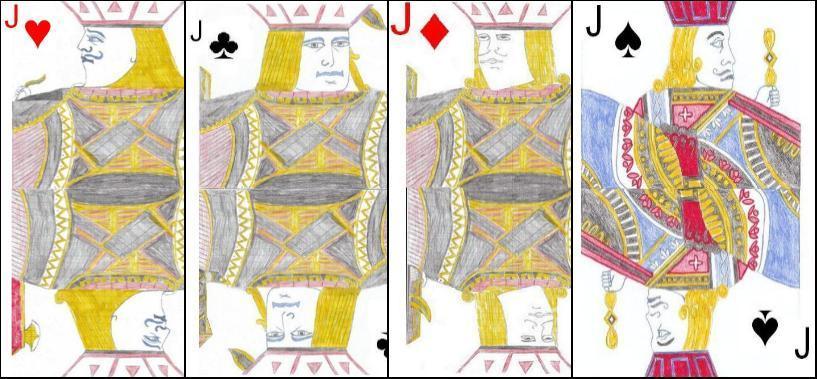 Jacks: When a Jack is played this immediately reverses the current direction of play. Thus, when the first Jack is played in a game, the direction will switch from the standard counterclockwise to counterclockwise. Each time during the course of the game that a Jack is played, the direction of play will reverse again. Therefore, the player who played the card immediately preceding the play of the Jack will then have another turn as the rotation of play has changed. As with any other card, a player on his turn can play a Jack on another Jack, immediately reversing the direction of play again.
Jacks: When a Jack is played this immediately reverses the current direction of play. Thus, when the first Jack is played in a game, the direction will switch from the standard counterclockwise to counterclockwise. Each time during the course of the game that a Jack is played, the direction of play will reverse again. Therefore, the player who played the card immediately preceding the play of the Jack will then have another turn as the rotation of play has changed. As with any other card, a player on his turn can play a Jack on another Jack, immediately reversing the direction of play again.Scoring: |
|||||||||||||
|
If during the course of the hand the stock pile runs out of cards, all of the previously played cards in the center pile (except for the topmost exposed card, which was the card last played) should be gathered up, shuffled and placed face-down to start a new stock pile. Thus, when the stock pile is completely exhausted the discard pile is immediately turned face down, shuffled and used to start a new stock pile from which players will continue to draw from when unable to play on their turn.
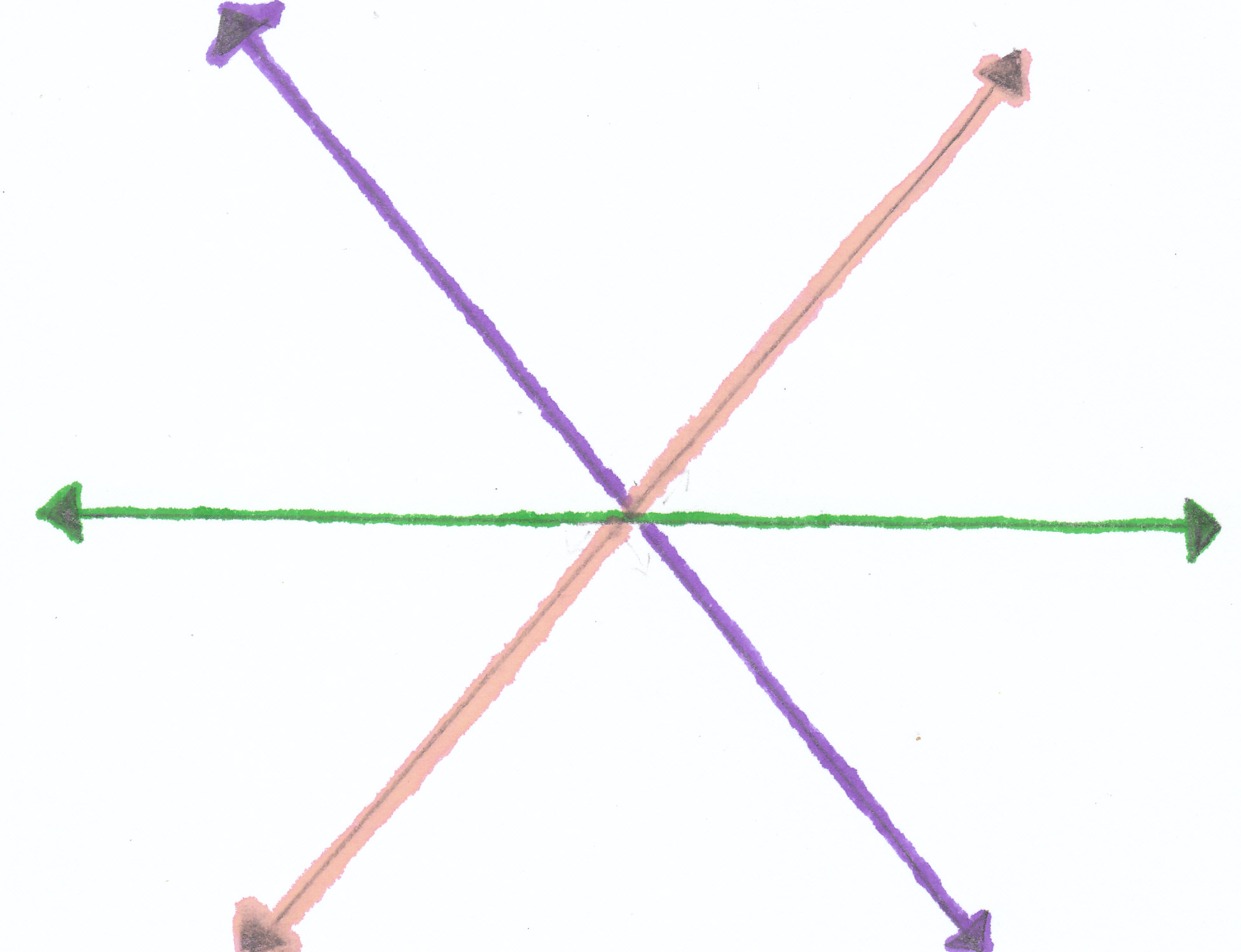 When a player plays a card such that he then only has one card remaining in his hand, he must immediately announce this by saying "Last Card". If they do not do this, they must then draw an additional card from the stock pile and miss his next turn.
When a player plays a card such that he then only has one card remaining in his hand, he must immediately announce this by saying "Last Card". If they do not do this, they must then draw an additional card from the stock pile and miss his next turn.The game can be played as each hand being a complete game, or play to a certain cumulative score over the course of several hands. If this is the case, once a player reaches the necessary score he is declared the winner of the game. Common scoring goals for such purposes are 500 or 1000.
|
Variations and Optional Rules
|
There are also a number of variations of Switch that are often played:
Additional Power Cards: In addition to the cards listed above which have special affects when played, there are sometimes other cards which are optionally given special status during the game. The following are some of these cards and their affects on the game when played:
|
Forced Play: Here, if a player has a card in their hand that they can play, they cannot draw and instead must play a valid card on their turn, if able. Most play this variation with the following exception to this rule: A player is NOT required to play a wild card (such as an Ace). Even if a wild card is the only card a player would be able to play, he need not play it and may draw from the stock instead if he does not choose to play this card.
Two card Signalling: In this variation, when a player plays his second to last card, he must signal in some, predetermined way that he has only one card remaining in his hand. If a player forgets to announce this, the player cannot play his last card on this turn and, depending on the variation, is usually penalized in some manner. Usually this penalty consists of the player being required to immediately draw an additional card or cards from the stock to add to their hand.
No Reshuffle: Using this rule, when the stock pile is depleted, if a player cannot, or chooses not to, play a card, he skips his turn with the turn passing to the next player in rotation. When, during a round, every active player skips his turn in this way, the hand ends and the scores are totalled for the hand.
Copyright © 2015
CatsAtCards.com. All rights reserved.
